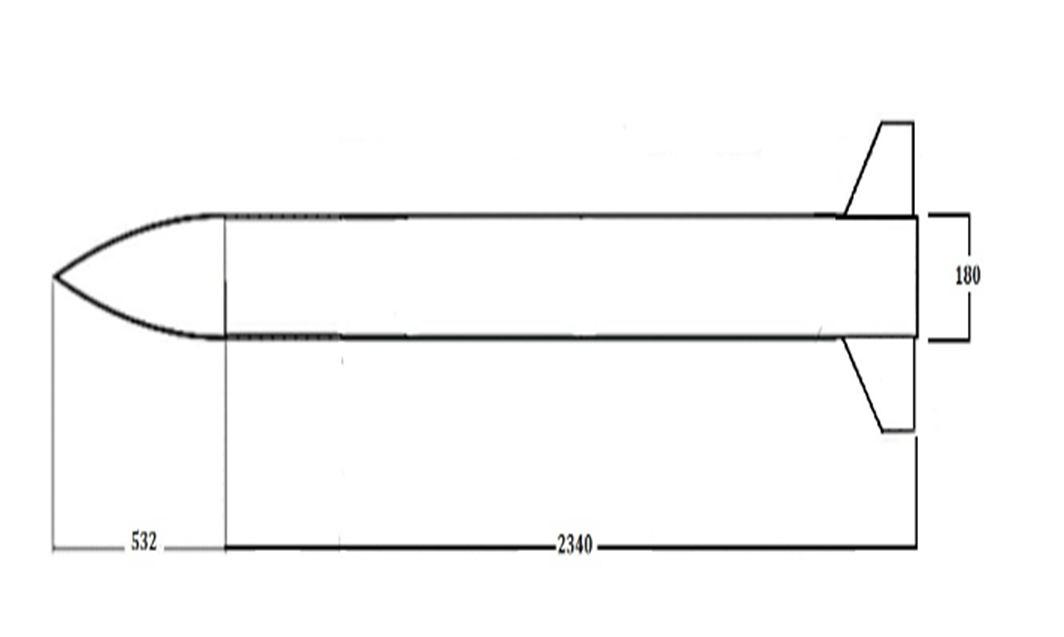
8 minute read
Aerodynamic Study of Various Fins for Missile Body
Kishor kumar Ukirde1, Swaraj Pawar2, Darshan Rahane3, Bhushan Sagar4, Tushar Shinde5
1Assistant Professor, 2, 3, 4, 5Undergraduate Student, Department of Aeronautical Engineering, Parul University, Vadodara, India
Advertisement

Abstract: This study aims to analyse the flow characteristics and drag profiles of six different fin geometries - clipped delta, swept, trapezoidal, elliptical, rectangular, and triangular - for subsonic, transonic, and supersonic flow at different Mach numbers. By comparing the aerodynamic characteristics of these fin variants, the research aims to identify the most efficient fin geometry for each Mach regime. This study will benefit missile designers in selecting the most suitable fin geometry for their mission by providing information on the efficiency of each fin geometry at different Mach numbers. The findings of this research will enable the development of more efficient and effective fins for missile models.
Keywords: Missile, Computational Fluid Dynamics, design methodology, subsonic flow, Supersonic flow, On-shape, Ansys.
I. INTRODUCTION
Missiles are powerful weapons with a wide range of applications, including military, scientific, and exploration missions. The design of a missile is crucial to its effectiveness and success, with each component serving a specific purpose. Among the major sections of a missile, the nose cone, mid-section, and boat tail section work together to maximize efficiency and stability during flight. However, the fins of a missile play a critical role in providing stability and control during flight, making them essential components in missile design. The design and analysis of missile fins involve a complete insight of aerodynamics. Any errors in the design or analysis of the fins can lead to a potential loss of the mission, making it vital to conduct a thorough analysis of the fins to ensure their proper functioning and reliability. Additionally, drag performance on missile fins is a critical aspect of missile design and analysis, and the study of various fin design can improve missile performance and accuracy. This research paper will explore the design principles and aerodynamic properties of missiles, with a particular focus on the design and analysis of missile fins and their drag performance at different Mach regime.
A. Missile
The classification of guided missiles based on their target type, range, control system, and guidance, as well as their trajectory. Different guidance systems, including command guidance, homing guidance, and inertial navigation guidance, can be used in guided missiles. There are four types of missiles: ballistic missiles, cruise missiles, and glide missiles, and skip missiles. Ballistic missiles use a projectile to carry warheads and travel outside the earth's atmosphere for most of their range, while cruise missiles travel their entire range within the atmosphere at a constant altitude and speed. Glide missiles are launched at a steep angle, reach a certain altitude, and then glide towards the target, while skip missiles are launched at a high altitude with a thin atmosphere and skip along the atmosphere to reach their target.
B. Section Of Missile
A nose cone is an aerodynamic part missile and rockets that helps to ensure maximum efficiency and stability by modulating airflow behaviour and minimizing aerodynamic drag. The conically shaped forwardmost section of a missile comes in different types such as conic, spherical blunted conic, bi-conic, tangent ogive, elliptical, and parabolic. The chosen nose cone type for this study is the ogive nose cone because it has an arc that smoothly meets the body contour, creating no break in the line where the ogive smoothly connects to the cylindrical body. The centre of rotation of the arc is in the plane of the base of the nose. The ogival nose cone comes in two fundamental types: the tangent ogive nose cone and the second ogive nose cone. Most of the missile have configuration cylindrical in shape. This shape is advantageous in drag, easiness of manufacturing and the load carrying capability.
The tail section of a missile is the after part of the body that typically tapers towards the end and has fins for stabilization and steering during flight. The boat tail is a tapered portion of the after section that reduces drag by decreasing the base area of the body, and the number and shape of fins can vary based on the type and purpose of the missile
ISSN: 2321-9653; IC Value: 45.98; SJ Impact Factor: 7.538
Volume 11 Issue II Feb 2023- Available at www.ijraset.com
C. Fins
Fins are used on smaller rockets and missile to provide stability and control direction, which ensures safe and predictable flight. Different fin designs will produce different centre of pressure positions and streamlined, and rounded fins can almost double their performance and altitude capabilities. Advantages of fins include increased control effectiveness, high strength-to-weight ratio, ability to function effectively at high Mach numbers and angles of attack, and convenience for storage and transportation purposes.
D. Drag
The drag analysis is a crucial aspect in missile design, as it prevents them from decelerating and reaching their maximum altitude. The analysis includes nose drag, body tube drags, base drag, and fins drag. Nose drag comprises both pressure and skin friction drag, and ogive-shaped cones experience lower drag than other shapes. Body tube drag is limited to skin friction and drag is lowest at a zero angle of attack, depending on the length-to-diameter ratio. Base drag is caused by low pressure at the missile's rear due to flow separation and is influenced by the exhaust's exit pressure. Fin drags comprised skin friction and induced drag and depends on the fin shape, cross-sectional shape, and contributes to fin drag.
II. LITERATURE REVIEW
The paper by Neerumalla Sumanth (2022) investigates the aerodynamic characteristics of a missile with trapezoidal and planar fins using CFD analysis. The study reveals that the use of trapezoidal and planar fins decreases the drag acting on the missile, and as the angle of attack increases, there is an increase in the value of Cl and a decrease in the value of missile with planar fins. The study also provides valuable insights into the velocity and pressure contour for both planar and trapezoidal fins, showing the maximum velocity and pressure at the front part of the nose and the minimum velocity and pressure at the rear part of the missile. Overall, the study can be useful in optimizing missile design for better performance. [1]
The study by Pektaş and Ejder (2019) investigates the effects of different fin shapes on the apogee and stability of model rockets. The study found that span length and thickness are the dominant factors affecting the apogee of the system for all fin shapes, and that increasing span length leads to a decrease in apogee and higher aerodynamic drag. The study also suggests that the stability of the model rocket is primarily determined by the span length of the fins, and that an increase in weight accompanies an increase in span length and thickness. The results can be useful in the design and optimization of rocket fins for better performance and stability, and the use of response surface analysis demonstrates the applicability of this approach in studying the effects of various parameters on rocket performance.[2]
The study by Nizam BIN Dahalan and Iskandar Shah Ishak (2017) aimed to investigate the aerodynamic characteristics of a curved fin rocket. The study used a semi-empirical method and numerical solutions at various Mach numbers for subsonic and supersonic speeds and angle of attack. The study found that the normal force coefficient and drag coefficient increased as the angle of attack increased, and as the angle of attack increased, the velocity contour on the bottom of the rocket was slower than that on the top. The study provides insights into the aerodynamic characteristics of a curved fin rocket that can be useful in the design and optimization of rocket fins for improved rocket performance.[3]

The study by Nahel Sharma and Rakesh Kumar (2017) uses computational fluid dynamics (CFD) to investigate the aerodynamic behaviour of a single generic planar fin of a semi-circular missile model at subsonic to supersonic speeds. The authors found that the geometry of the fin plays an important role in missile aerodynamics, and that the trailing edge of the fin had little effect on the flow pattern around the fin. The study also found that the drag coefficient is dependent on the Mach number and that distinct oblique shock waves were observed after Mach 0.8. The insights from this study can be useful for the design and optimization of missile fins for improved performance.[4]
The study by Emran Gulay et al. (2011) investigates the rolling moment coefficient of missile models with wrap-around fins (WAF) using computational fluid dynamics (CFD) and experimental data. The study aims to understand the effect of WAF on missile performance in subsonic, transonic, and supersonic flows. The study found that the calculated rolling moment coefficient for the WAF model differed from the measured rolling moment coefficient by 14% in the supersonic region and 18% in the subsonic region. The study also highlights the importance of validating CFD results with experimental data and can be useful in the design and optimization of missile fins for improved performance.[5]
The study by James DeSpirito et al. (2002) investigated the aerodynamic coefficient and flow field of a generic canard-controlled missile configuration in supersonic flow using planar and grid fins. The authors used CFD simulations and found that grid fins produced lower side forces and reduced rolling moment compared to planar fins due to the uneven pressure distribution on the grid tail fins resulting from the interaction with the canard trailing vortices.
ISSN: 2321-9653; IC Value: 45.98; SJ Impact Factor: 7.538

Volume 11 Issue II Feb 2023- Available at www.ijraset.com
The study also highlighted the strong effect of canard deflection on the missile's forces and the ability of the canard's small surface area to reverse the rolling moment. The study provides valuable insights for the design and optimization of missile fins and can be useful in developing more efficient and effective missile fins for improved missile performance.[6]
The study by Kenneth J Moran and Philip J. Beran (1997) aimed to predict and understand the static stability characteristics of a generic missile configuration at high Mach numbers by simulating the flow around a complete Hypersonic Applied Research Technology missile for inviscid, laminar, and turbulent conditions at Mach numbers from 2 to 6. The study found that the pitching moment was dominated by compressibility effects, and the effectiveness decreased with increasing Mach numbers. The study provides insights into the static stability characteristics of a swept fin missile at high Mach numbers, which can be useful in the design and optimization of missile fins for improved missile performance in hypersonic flight.[7]
Munson et al. conducted a study in 1965 to investigate how the shape of missile fins impacted their aerodynamic characteristics, for both subsonic and supersonic missiles. They determined that a trapezoidal fin with a swept-back design was the most efficient shape for both types of missiles.[8]
In 1983, Watkins et al. studied the effect of missile fin size and shape on the missile's trajectory. The authors found that increasing the fin size and sweep angle improved the missile's stability and reduced drag.[9]
CFD analysis has been used in several studies to enhance missile fin design. In 2019, Mawhood et al. conducted a study using CFD simulations to improve the design of missile fins for a supersonic missile. The study discovered that the most efficient and stable fin design is a combination of anhedral angle and sweep angle.[10]
Overall, the literature suggests that missile fin design and analysis play a critical role in improving the overall performance of missiles.
III. MISSILE SPECIFICATIONS AND CONFIGURATIONS
A.
Specification Of The Missile
Figure1 depicts the designed Missile dimensions. In millimetres, the specified dimensions are given,


